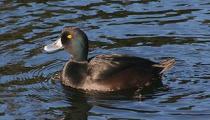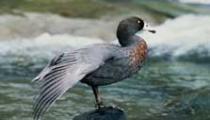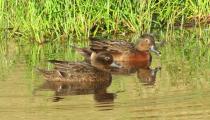There are four key waterfowl species which are protected, and cannot be hunted in New Zealand.
There are four key waterfowl species which are protected, and cannot be hunted in New Zealand:
Grey Teal
 This Australian duck was thought to have come to New Zealand last century. However, its bones have since turned up in centuries-old midden sites, suggesting a much earlier arrival.
This Australian duck was thought to have come to New Zealand last century. However, its bones have since turned up in centuries-old midden sites, suggesting a much earlier arrival.
The grey teal nests near its favoured freshwater lakes and marshes, usually on the ground, but also in tree holes or rabbit burrows. Their fondness for nesting in hollow trees has led sportsmen and women to put up thousands of nesting boxes to encourage an increase in numbers. But their numbers will have to be raised still further to justify a limited hunting season.
Grey teal are a mottled brown duck with white and green flashes on their wings. They are a vocal duck, especially at night. The male gives a soft preep, and the female has a loud quack.
Scaup (Black Teal)
 New Zealand’s only diving species, the native scaup (also known as the black teal) is a dumpy little duck common on clear water lakes such as those around Rotorua. In the Maori language, scaup are commonly known as papango, also matapouri, titiporangi, raipo.
New Zealand’s only diving species, the native scaup (also known as the black teal) is a dumpy little duck common on clear water lakes such as those around Rotorua. In the Maori language, scaup are commonly known as papango, also matapouri, titiporangi, raipo.
Although scaup are found throughout both the North and South islands in deep freshwater lakes and ponds, farm sediment has clouded many lakes, causing scaup to abandon them. “Streamcare” groups that aim to restore water quality may hold hope of the scaup’s eventual return. They have been protected since the 1930s.
Overall scaup are dark brown/black-coloured. The male has a striking yellow eye and a dark coloured (greenish) head. The female is similar to the male, but without the yellow eye and has a white face patch during breeding season. A white wing bar can be seen in both sexes when in flight.
Blue Duck (Whio)
 The blue duck (Maori name: whio whio) is a river specialist which inhabits clean, fast flowing streams in the forested upper catchments of New Zealand rivers. They occur nowhere else in the world.
The blue duck (Maori name: whio whio) is a river specialist which inhabits clean, fast flowing streams in the forested upper catchments of New Zealand rivers. They occur nowhere else in the world.
This native New Zealand duck is a “torrent” species, at home on forest streams and rivers where it feeds among rocks on aquatic insects. Because of this specialised niche, blue duck have unique features such as a streamlined head and large webbed feet to enable them to feed in fast moving water. They also have a flexible bill unique among the world’s many waterfowl.
Blue duck establish exclusive territories. Strong pair bonding results in individual pairs occupying the same stretch of river year after year which they aggressively defend against other blue duck, as well as grey duck, paradise duck and even shags or gulls.
Blue duck are recorded by the International Union of Conservation for Nature (IUCN) as "endangered" because it has a very small and severely fragmented population which is undergoing a rapid decline owing to a variety of factors, most notably the impact of introduced predators.
They are a diving duck and may stay down for 20 to 30 seconds and go down three metres to look for aquatic plants, small fish, water snails, mussels and insects.
Brown Teal (Pateke)
 Pāteke/brown teal are a small dabbling duck endemic to New Zealand. They are mottled brown in colour, with a white ring around the eye. Males are easily distinguishable from females in their breeding plumage (during the autumn and winter months) with their iridescent green heads and chestnut-coloured breasts.
Pāteke/brown teal are a small dabbling duck endemic to New Zealand. They are mottled brown in colour, with a white ring around the eye. Males are easily distinguishable from females in their breeding plumage (during the autumn and winter months) with their iridescent green heads and chestnut-coloured breasts.
Pāteke flock during the non-breeding (summer) months and breed during winter. They do most of their feeding at night in seeps, swamps, damp pasture and the shallows of drains, streams, ponds and estuaries. They eat a variety of grasses, seeds, insects, molluscs, worms and many other invertebrates.
Pāteke were once found throughout the forests and wetlands of New Zealand, but underwent a dramatic decline during from the 19th century due to habitat loss, predation and probably excessive hunting in some areas. By the 1990s, the remnant range of pateke was restricted to less than 1000 birds on Northland's east coast and Great Barrier Island. Intensive predator control and a strong captive breeding and release programme has allowed pateke to recover to around 2500 birds distributed across a number of sites around New Zealand.
Pāteke now occur mainly on lowland floodplains, typically where there are combinations of pastoral land, forest remnants, wetlands, and estuaries. Pateke are smaller, and fly lower and faster over the water (faster wing beat) than grey or mallard ducks. They have more white on their wings but could easily be mistaken for a mallard duck (similar colour) or New Zealand shoveler (similar size and wing beat).